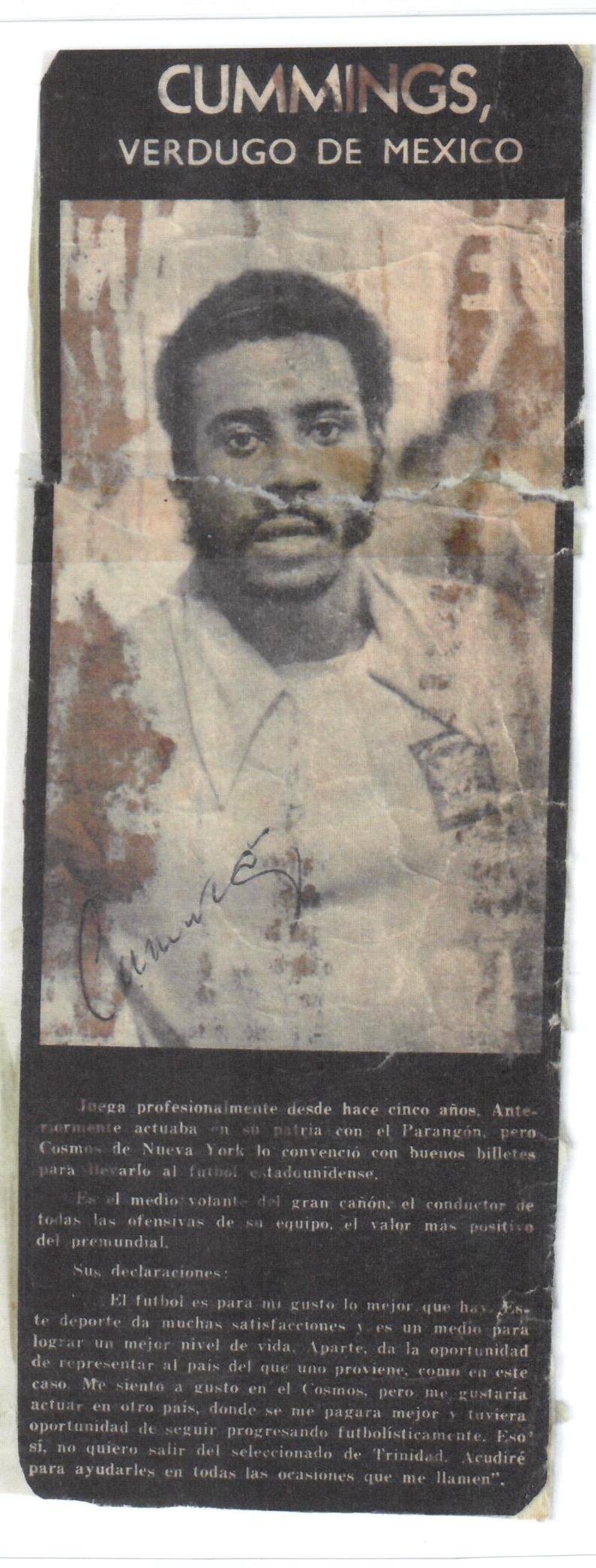I penned the following reflections in 2001 as I was contemplating on where our football was headed sitting in our apartment in Manhattan, New York, after the end of our campaign for the 2002 FIFA World Cup in Japan/South Korea. Now in 2013, with a newly elected president of the TTFF, my reflections continue to be relevant then as they are now.
Leadership and decision making at the helm will determine where we go from here. We have to develop a new culture in the management of football where excellence should be the main goal.
We cannot lose this opportunity to put new structures in place if we want to put football on a trajectory to continuous improvement. This is necessary to regain the confidence of football fans and the stakeholders in general and to be a competitive force in the region and a fixture on the international stage.
I wrote then:
“T&T’s success at the World Cup qualifying preliminaries in Haiti in 1973, ushered in new hope in football administration as it was felt then that the Eric James dictatorial era came to an end. James was the secretary treasurer of the FA and was replaced by Austin Jack Warner.
The late Ken Galt, a former national player, was at that time the President of the FA. He was very instrumental in the success of our national team in Haiti. Galt always tried his best to maintain credibility. His relationship with the players was very strong and he was highly respected.
Players and coaches felt comfortable to see someone at the helm who had played the game at the national level. There was comfort in knowing that someone understood the needs of players and coaches, and cared. Galt did a fantastic job as president and managed relations with other officials opposed to the type of relationships he had developed with players and coaches.
John Alleyne, the then president of the South Zone took over from Galt as president on his passing and had a most difficult job to manage relations between the North, East and South Zones and did not have the type of relationship Galt had with players. It was a continuous struggle to protect and honor the football constitution and uphold its democratic principles.
After the Galt era, football administration has been on a roller coaster ride. I remember players being victimized and football careers ended if they had an opposing view. Some decided to jump off. Selection of coaches and players, for national duty, were based on a “do as I say principle.” It was also about friendships and club loyalties.
This created serious football issues and conflicts which weakened nationals teams for decades to come. Football stars, of that era took early retirement instead of getting involved in mudslinging with the administration. The game suffered because of the constant struggle between administration, clubs, players and coaches.
Many of those players who were at their peaks opted for playing “fete match” all over the country since there were no room for dialogue. It was then I in 1977, I decided with Euadne Gordon, a hockey administrator and past national hockey player, to start a touring professional team called Pro Pioneers which comprised of outstanding national players to play club teams in the Caribbean, Central and South America in order to keep them active and for possible future national selection.
Some of those players included Ron la Forest, Sammy Llewellyn, Leroy Spann, Leon Carpette, John Granville, Stuart Charles and Selris Figaro. A highlight of that team was playing against Deportivo Cali to a sold out crowd at the opening of the stadium in Meta, Columbia.
In 1982, when Arthur Suite started the Premier Soccer League, with that same nucleus of players, he addressed the need of players and coaches who were victimized by the football administration. This move brought the crowds back to football but not without lots of confrontation and threats from the FA. The league was short lived and institutional teams like Trintoc, Defence Force, Police, Fire Services, and Prisons Services all played a very crucial part in player survival.
In 1987, on secondment from Ministry of Sport, I got the opportunity to put my ideas for the development of football in place, and the rest is history. At that time Peter O’Connor was president and I recall after the game on November 19, 1989, his arms were the first to comfort.
Peter provided excellent leadership during the campaign. In 1994, while serving as technical director, Oliver Camps by then had assumed the Presidency.
We were successful in regaining the Shell Caribbean Cup from Martinique defeating them 7-2.
In 1997, I moved to New York.
Today, some of the same people who wrote against the then-poor administration and who, in articles, sought to protect the football constitution and democratic principles have now manipulated the inadequate structures for selfish interests.
The many differing agendas by members of the football fraternity eventually interfered with long term development of the game. The reconstructing and redirecting of T&T football was a well orchestrated plan to control the football revenue, coaching positions, perks and international business.
A lack of vision for the overall development of football destroyed the various league structures, the foundation of community-based clubs, and by extension the minor league competitions, which at that time were the only ones with organized football for the different age groups.
After primary schools’ football, young players were then introduced to their age groups in the minor leagues. If you were good enough, you could have joined a club and played football in the first or second division in one of the TFA leagues.
I always wondered what kind of research or evaluation was done and who were the experts who guided those decisions to reconstruct and redirect T&T football.
The old system in the 50s and 60s was made up of various leagues which represented the clubs under TFA’s affiliation, and were responsible for management of their own affairs. At least 90 percent of whatever revenue was made from club football went to the respective leagues, not the TFA.
They also played an important part in the affairs of running football. The TFA earned money from inter-league encounters, ‘north versus south classics’, and various international matches.
Those were the days when football administrators, like players and coaches, had to earn their selection to another level of administration, climbing the ladder from club level to league level, then to national football. The wide representation and participation of persons throughout the system made it very difficult for any one person to control everything and everyone in the organization.
But, the removal of the league structures brought an end to so much that was good and worth keeping, for example, inter-league football competitions and ‘north versus south classics’ which showcased future national footballers, coaches, managers and administrators.
After the removal of the league structures, a national league was initiated, which centralised everything. Responsibility was snatched away from the leagues and communities and football fell smug into the hands of the governing body.
Clubs were then selected by the governing body for a place in the newly formed national league.
 The communities got weaker and weaker because of this and the exodus of players started. Players now had to leave their communities and travel elsewhere to represent other clubs in other communities.
The communities got weaker and weaker because of this and the exodus of players started. Players now had to leave their communities and travel elsewhere to represent other clubs in other communities.
Prior to those changes, football had always attracted large crowds in T&T. All over the country, playing fields, parks and grassy areas were packed with footballers working on their craft almost seven days a week. It would have been easier to start football professionally through these communities because of the automatic crowd support.
The destruction of the various league structures which linked the communities to the TFA, also helped to destroy the ethnic involvement which football once had. Ethnic diversity was seen in some communities throughout the country and through national representation on the football field. Today, ethnic diversity is mainly visible at the Secondary Schools Football League.
The public supported football at every level.
I remember playing to sold out crowds at the Queen's Park Oval, Skinner Park, Mahaica Oval, Fyzabad Recreation Ground, Sangre Grande Recreation Ground, Palo Seco, Forest Reserve, Arima, Chaguanas, and other popular football venues.
Imagine, they were sold out for local club games, inter-league, and ‘north versus south classics’. We must remember and understand that when players moved on from the SSFL level to first division club football, the fans also followed, and that's where the core club support came from. This transition wasn't only made by the players, but also by the supporters.
T&T football is at the crossroads and needs a new direction. The time is right to start rebuilding and redirecting the game from the bottom up, starting at the community level.”
As I reflected then in 2001, now in 2013, we still need to:
*Reorganize football in the zones with focus on the development of players and officials.
*Establish Zonal Technical Committees to guide football development in the zones.
*Establish a National Senior Technical Committee to advise national teams.
*All football leagues including the professional league must fall under the jurisdiction of the TTFF.
*Re-establish various structures within the governing body with highly competent individuals to run the affairs in areas such as financial management, marketing and communications.
*Strive for Excellence at all levels.
These are just a few areas that need to be addressed. Over to you, Mr President.
